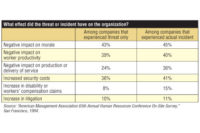Safety Check: How Can Colleges Address Risk in a Campus Carry Environment?

Today in America, Second Amendment rights and university security missions are seemingly at odds. Recent legislation allows licensed firearms to be concealed-carried on campuses in Arkansas, Colorado, Idaho, Kansas, Mississippi, Oregon, Utah, Tennessee, Texas and Wisconsin. Twenty states, plus the District of Columbia, currently have statutes or regulations that prohibit possession of firearms in colleges, universities and other post-secondary educational institutions, with various caveats. Arkansas’s law, for example, only applies to handguns. A number of states have passed specific “Campus Carry” laws mandating that concealed firearms be permitted on some or all areas of college and university campuses.
As campuses try to apply Section 5(a)(1) of the Occupational Safety and Health Act (OSHA) in providing for safe and secure workplaces, not to mention legal expectations under the Clery Act, licensed carry advocates argue their constitutional rights are not to be infringed. College campuses find themselves caught between their moral responsibilities to provide a safe workplace and educational institution while respecting citizens’ right to bear arms.
From a college and workplace security perspective, the essential point of this argument is centered on the ability of colleges, universities and schools to protect students and staff and public from a threat posed by a disgruntled parent, student or employee. Such environments are, by their very nature, difficult to protect without an organizational commitment and investment and community understanding. The work and dedication of the campus community is absolutely necessary regarding the implementation or restriction of on-campus firearm rules.
Campus Carry advocates might fail to consider that universities are often emotionally charged places, with a high population of young adults, frequent workplace disputes, high-stress classes and competition for resources – all potential causes of escalating violence, especially when on-campus housing is taken into account. The state laws assume that the legally authorized licensees are not a threat, but the licensee might not be the only one with access to the weapon. Some will argue that creating gun-free zones doesn’t work because they actually attract criminals as soft targets. That position dismisses the internal threat posed by the employee or non-criminal threat.
More than 4,000 colleges and universities in the United States prohibit the carrying of firearms on their campuses. They argue that their gun-free policies helped make college campuses safe environments even when compared against national averages. For example, a 2001 U.S. Department of Education study found that the overall homicide rate at post-secondary education institutions was 0.07 per 100,000 students in 1999, compared to the national homicide rate of 5.7 per 100,000 people. A Department of Justice study found that 93 percent of violent crimes that victimize college students occur off campus.
While many universities no longer have a choice regarding a Campus Carry rule, it’s worthwhile to continue a meaningful dialogue with the community and university stakeholders to address whatever risk you can.
The argument that students or staff carrying a licensed firearm will stop or prevent violence is not true. This assumption is a false sense of security. Those who cross the line of civility in pursuit of retaliation commit to methodical plans an execution process similar to the planning undertaken by terrorists. We see that methodical planning conceived in the five stages of the active shooter in describing the shooter’s mindset (Fantasy, Planning, Preparation, Approach, Implementation). The shooter does not announce or promote the event; he picks the day, time and location. Many enter the final stage of their attack planning a suicide by police; the presence of more armed civilians may not always be a deterrent to the attack taking place, as the attacker expects to be killed.
Nevertheless, universities have to review their security plans and security management philosophies in response to these evolving regulations and threats. The potential college campus avenger can be a student, employee or non-employee.
Workplace violence and college campus violence are often emotional crimes of passion, vengeance and retaliation: the student who expects a better grade or has a vendetta against the professor angrily lashes out; the employee with coping issues ostracized and eventually fired; the love triangle or jilted lover. These festering emotional issues provoke emotional reactions. Without swift, effective intervention or crisis resolution, the incident escalates. How does one stop an angry person who transitions from disgruntled to homicidal thoughts?
Awareness
College students do not always lock their dormitory doors, making unsecured firearms a prime target for opportunistic thieves. Students typically have the feeling of invincibility, and they make inappropriate allowances. Sound judgement and critical thinking typically help in the conflict resolution process, but there is concern that when young people are involved, emotions run high, and logic goes out the window, resulting in bombastic exchanges.
Well-intentioned court actions might not have considered the value of a critical vulnerability assessment instead arguing the authorization to carry rationale. Victims of harassment, verbal abuse or even stalking who are authorized to carry a firearm might decide to confront the individual or take the law into their own hands, while the unarmed student might have reported the incident to the school or law enforcement. University leaders must consider training for students and staff on how to handle police response situations. Signs might be posted conspicuously announcing instructions for visitors and guests who are armed.
Students and staff need to be trained in how to interact with police in an emergency situation or while carrying their firearm. Police response to a shooter incident is “HOT” and deliberate, and at a “Campus Carry” school, they must react to potentially violent incidents expecting participants to be armed. Improper reactions could result in innocent people being injured or even killed. Appropriate training addresses individuals’ responsibilities when police arrive on the scene. The issue of authorized carry is now tied to one of quality training and responsible behavior, which the university and local first responders can help to enable through education.
Training
Advocates will argue that there is no difference between college campuses and other public places, and that the training these individuals receive when getting their licenses adequately prepares them. However, as previously discussed, college campuses have a variety of unique factors, and additional quality training – either through the concealed-carry instructors or through university programs – may be necessary. Training topics could include appropriate behavior and judgement scenarios, how to secure firearms on campus, interacting with police and appropriate use of force procedures.
Proactive Policies and Procedures
Campus administrators and security management personnel must begin discussions around the need for the development of appropriate policies on the use of force, handling and storage of weapons, police response, personal behavior and training. Crisis management considerations must address prevention and violence response protocols and measures.
There are inherent uncertainties college campus administrators must anticipate. The number of students and staff with firearm access; the level of assumed training administered by authorized concealed-carry trainers; the potential for disputes, confrontations, breakdown in personal and intimate relationships; and the lack of mature judgement all contribute to a potential melting pot of conflict.
Drawing from my own experiences as a workplace violence prevention consultant, a gun makes the person carrying the weapon feel safer. Students, staff and visitors will never know the time or place that a disgruntled person will escalate to homicide and burst through your doors with guns blazing. Having a gun makes you feel powerful when things are under control, but you can’t prevent the shooter from shooting innocent victims. You can only react after the shooting begins.
Like every workplace, college campuses must make a commitment to invest in workplace violence prevention and violence response policy, plans, procedures and training in creating a culture of responsible and accountable behavior. In a litigious atmosphere, college campuses have an obligation to take proactive measures in addressing conflict or the perception of issues that can escalate to conflict and the unfortunate homicidal act of violence.
Looking for a reprint of this article?
From high-res PDFs to custom plaques, order your copy today!





